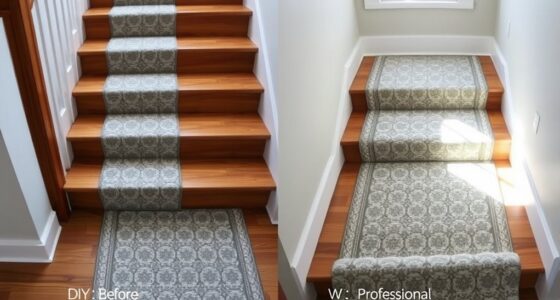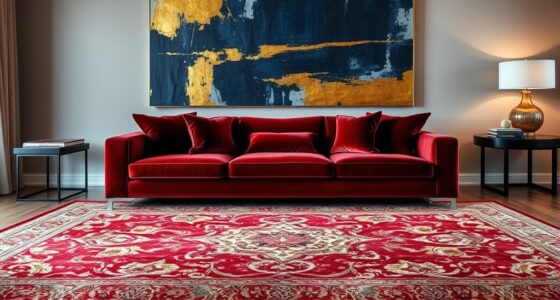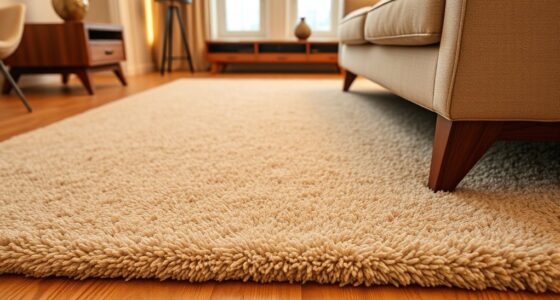Decorating your library with large-scale carpets can transform the space by improving acoustics, defining areas, and matching your design theme. Choose sizes and shapes that fit your layout, and pick colors and patterns that enhance the atmosphere—whether calming neutrals or vibrant motifs. Opt durable, comfortable materials like wool or eco-friendly fibers, and consider layering for visual interest. If you want to discover tips on placement, maintenance, and creating inspiring decor, keep exploring further.
Key Takeaways
- Choose carpet designs and colors that complement the library’s overall style and create a cohesive aesthetic.
- Opt for durable, sound-absorbing materials like wool or dense synthetic fibers to enhance acoustics and comfort.
- Use large, subtle patterns for expansive carpets to unify space or bold motifs to create focal points.
- Coordinate carpet placement with furniture and traffic flow to optimize accessibility and prevent overcrowding.
- Incorporate cultural motifs or storytelling symbols to add depth, celebrate diversity, and invite curiosity.
Choosing the Right Size and Shape for Your Library
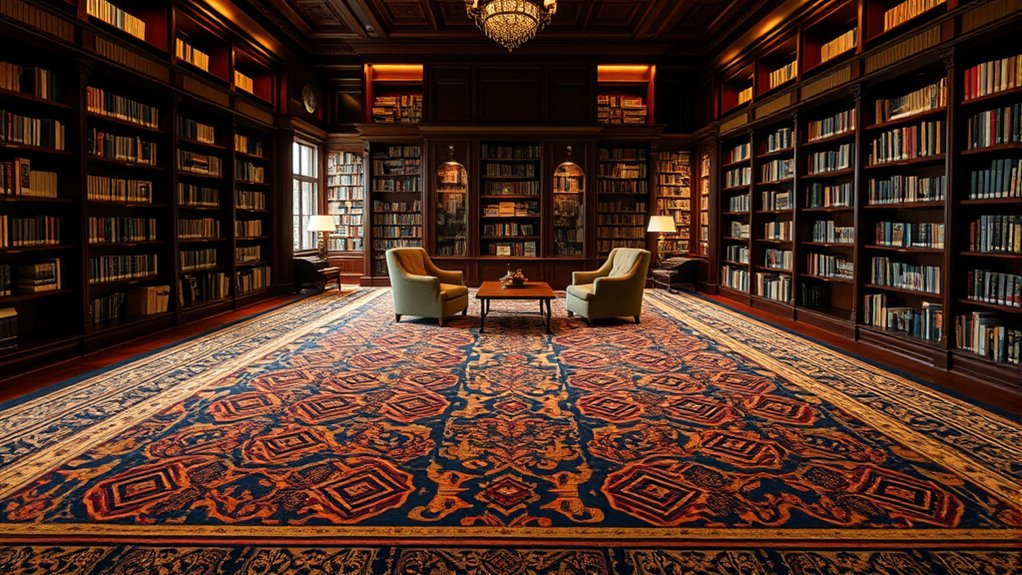
When selecting the size and shape of your library, it’s essential to take into account both your space constraints and your collection’s needs. Your library layout should optimize space utilization, ensuring enough room for shelves, seating, and pathways. Think about how much storage you require and how visitors will navigate the area comfortably. A compact, rectangular layout might work best for smaller spaces, maximizing wall use, while a larger, open-plan design can accommodate diverse zones like reading nooks or study areas. Consider the flow of traffic and the accessibility of your collection. Proper planning at this stage helps you avoid overcrowding or wasted space, creating a functional and inviting environment tailored to your collection size and the available room. Additionally, effective space planning can enhance the overall user experience and encourage community engagement within your library. Incorporating furniture placement strategies ensures that the space remains comfortable and accessible for all users. Paying attention to safety standards in furniture and layout design is also crucial for creating a secure environment. Being aware of projector technology options can also help in integrating multimedia elements smoothly into your library design. Furthermore, considering essential oils for creating a calming atmosphere can improve visitor comfort and satisfaction.
Selecting Colors and Patterns to Complement Your Space

Choosing the right colors and patterns can dramatically enhance your library’s atmosphere and functionality. Your color palette sets the mood—calming neutrals foster focus, while bold hues energize the space. When selecting patterns, consider scale and style; large, subtle designs can unify a large carpet without overwhelming, while smaller, intricate patterns add visual interest. To optimize your pattern selection, think about how it complements existing furniture and decor. Balance vibrant colors with neutral tones to avoid visual chaos. Remember, the goal is harmony—your carpet should enhance, not compete with, your library’s architecture and furnishings. Additionally, understanding the WWE Raw’s Financial Impact can inspire sophisticated decor investments, reflecting wealth and success. Incorporating knowledge of ethical hacking can also guide you in choosing secure and durable materials that resist damage and wear over time. For a cohesive look, consider the Personality Test traits of your space, ensuring your decor aligns with your desired atmosphere and personal style. Practicing stillness can help you gain clarity on your design preferences and create a more intentional space that promotes tranquility and focus. Moreover, embracing failure in creativity can encourage exploring innovative design ideas without the fear of imperfection.
Material Options for Durability and Comfort
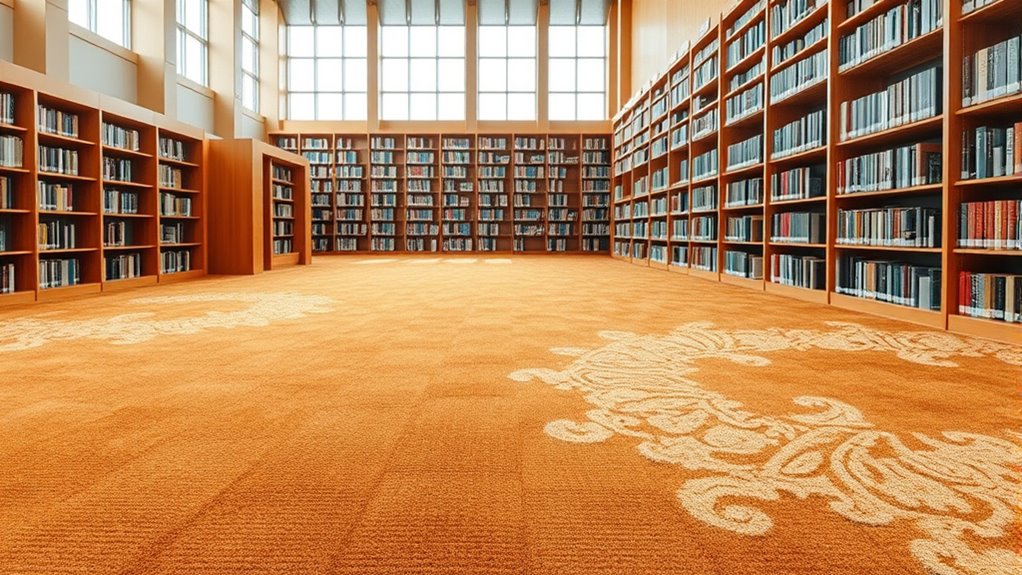
Choosing the right rug material can make a big difference in your library’s durability and comfort. Some fabrics withstand heavy foot traffic better, while others offer a softer feel underfoot. Consider your needs carefully to find a balance between wear resistance and cozy appeal. Paying attention to trust issues can help you select materials that last longer and maintain their appearance over time. Additionally, understanding data privacy challenges related to material durability testing can ensure you select options that are both reliable and safe for your environment. For example, selecting materials with test results indicating high resilience can be beneficial in high-traffic areas. Being aware of material performance data can guide you towards choices that effectively combine durability and comfort. Moreover, reviewing industry standards can assist in choosing carpets that meet safety and performance benchmarks.
Rug Material Choices
Have you considered how the material of your library rug impacts both durability and comfort? Choosing the right fiber textures can profoundly influence how well your rug withstands foot traffic and how inviting it feels underfoot. Opting for eco-friendly materials not only supports sustainability but often offers resilience and natural appeal. Consider these options:
- Wool, known for its durability and soft fiber textures, ideal for high-traffic areas.
- Jute or sisal, which are eco-friendly materials that provide a rustic look and natural resilience.
- Recycled nylon or polyester, combining durability with eco-conscious choices, often resistant to wear and stains.
- Understanding the Fokos website’s cookie categories can help you manage your browsing preferences while researching different rug materials online. Additionally, selecting appropriate cleaning methods for each material will extend the lifespan of your large-scale carpet. Incorporating heat pump technology into your building management can also improve indoor climate stability, supporting the comfort of your library environment.
Selecting the right material ensures your large-scale carpet remains both functional and beautiful, enriching your library’s ambiance while standing the test of time.
Comfort and Wear
Selecting the right material for your library rug directly affects both its comfort and durability. You want a surface that feels soft underfoot while standing up to heavy traffic and wear. Wool is an excellent choice, offering natural soundproofing and resilience, plus it’s good for allergy considerations since it’s hypoallergenic. If allergies are a concern, synthetic fibers like nylon or polyester can provide durability and easier cleaning without sacrificing comfort. Consider dense, tightly woven carpets for better sound absorption, creating a quieter reading environment. Regular maintenance extends your rug’s lifespan, maintaining both comfort and appearance. Ultimately, balancing material strength with softness ensures your large-scale carpet remains inviting and functional for years to come.
Incorporating Style Themes With Carpet Designs
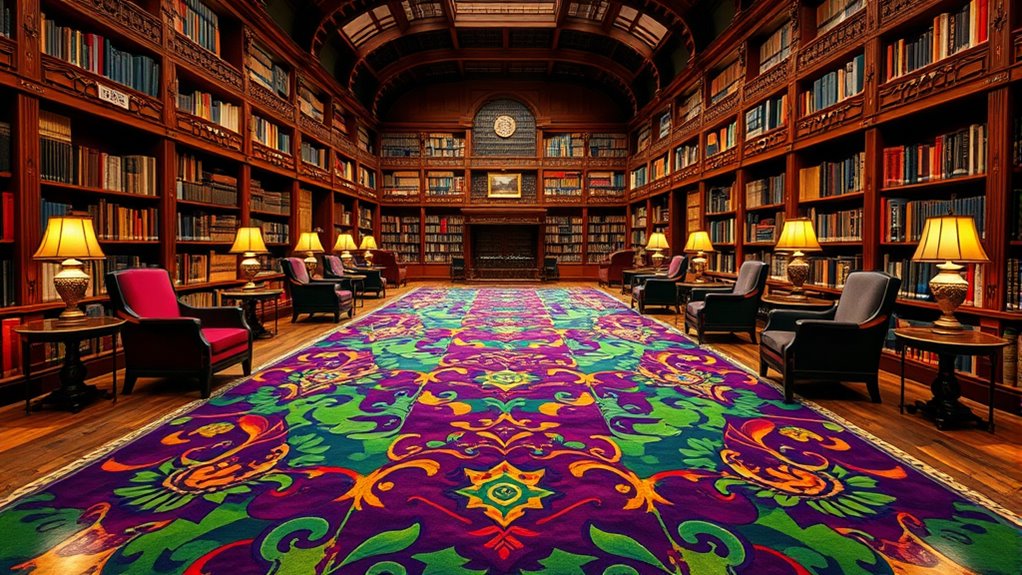
Choosing carpet designs allows you to coordinate colors and patterns that complement your library’s overall style. You can also reflect cultural themes to add depth and meaning to the space. By doing so, you’ll enhance the atmosphere and create a mood that invites both focus and relaxation.
Coordinating Colors and Patterns
When coordinating colors and patterns for library carpets, you should aim to harmonize them with the overall style theme of the space. Focus on achieving color harmony by selecting shades that complement existing decor, creating a cohesive look. Balance patterns by mixing bold designs with subtle ones to prevent visual overload. Keep in mind that a well-balanced pattern enhances the room’s aesthetic without overwhelming it. To help you get started, consider these tips:
- Match carpet colors with the library’s primary color palette for consistency
- Use patterns that reflect the library’s theme while maintaining pattern balance
- Incorporate accent colors for visual interest without disrupting harmony
This approach ensures your carpet design enriches the space while supporting its style theme.
Reflecting Cultural Themes
Incorporating cultural themes into library carpet designs allows you to celebrate the diversity and identity of the space. Using cultural motifs, you can embed stories and symbols that reflect different traditions, enriching the environment. These designs serve as visual storytelling elements that invite curiosity and learning. To create harmony, consider how motifs relate to the library’s purpose and audience. For example:
| Cultural Motifs | Themed Storytelling | Design Impact |
|---|---|---|
| Asian dragons | Folklore themes | Adds vibrancy |
| Tribal patterns | Ancestral tales | Enhances heritage |
| Celtic knots | Mythical stories | Promotes curiosity |
This approach makes your library more engaging and respectful of diverse backgrounds, fostering a deeper connection with visitors.
Enhancing Ambience and Mood
Integrating style themes into carpet designs can substantially influence the library’s overall atmosphere, shaping how visitors feel and interact with the space. Thoughtful patterns and colors can create a calming environment that encourages focus or energize the mood for social areas. Carpets also improve acoustic absorption, reducing noise levels and making conversations more comfortable. Additionally, strategic carpet placement enhances lighting by reflecting or diffusing it, creating a warm, inviting ambiance. To achieve this, consider:
- Choosing patterns that complement lighting schemes to boost mood
- Using colors that promote relaxation or alertness
- Selecting textures that absorb sound and soften the environment
These elements work together to craft an ambiance that supports both quiet study and lively gatherings, enriching the library experience.
Tips for Proper Carpet Placement and Layering

Proper carpet placement and layering can substantially enhance the overall look and comfort of your library. Start with layering techniques by placing a large, central rug as the foundation, then add smaller rugs or carpets to define different zones. When mixing patterns, choose complementary colors and textures to create visual interest without clutter. For example, pair a solid-colored carpet with a patterned one that shares a similar color palette. Confirm the rugs are properly aligned, with edges overlapping slightly or neatly touching to prevent tripping hazards. Keep furniture legs on the main carpet or area rug to anchor the space. Layering and pattern mixing add depth, warmth, and style, making your library inviting and visually appealing.
Enhancing Acoustics With Large-Scale Rugs
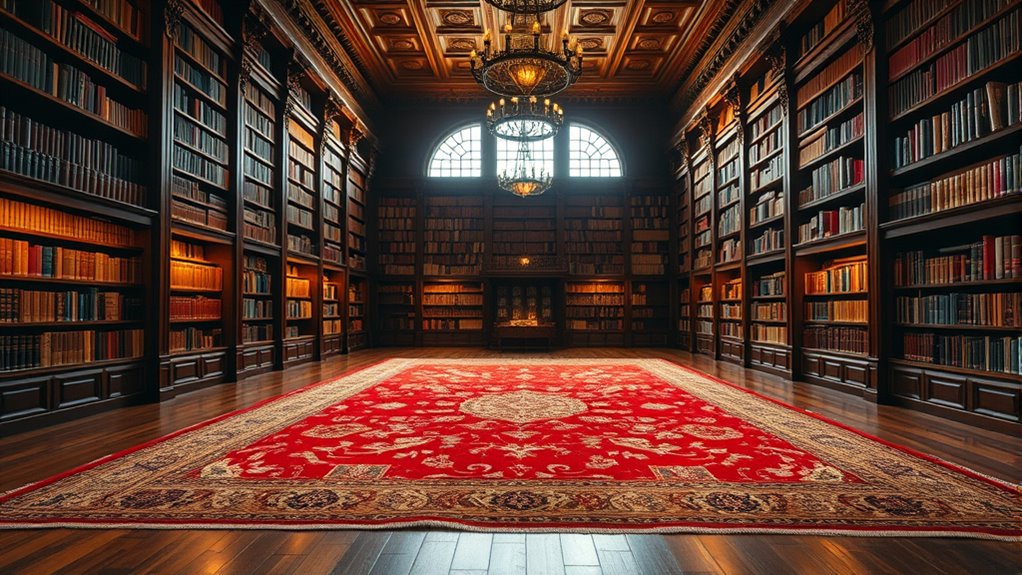
Large-scale rugs can considerably improve your library’s acoustics by absorbing sound and reducing echoes. This enhances speech clarity and creates a quieter environment. By focusing on acoustic absorption, your rugs prevent sound waves from bouncing around, minimizing noise disturbance. Additionally, they provide sound insulation, blocking noise from adjacent areas, which is especially helpful in busy libraries. To maximize these benefits, consider the rug’s material and thickness. Thicker, dense fibers are more effective at dampening sound. Positioning large rugs under reading tables and seating areas can further enhance sound absorption and insulation.
- Choose rugs with dense, plush fibers for better acoustic performance
- Place rugs strategically to target high-traffic zones
- Combine rugs with wall panels for optimal sound control
Maintenance and Care for Library Carpets
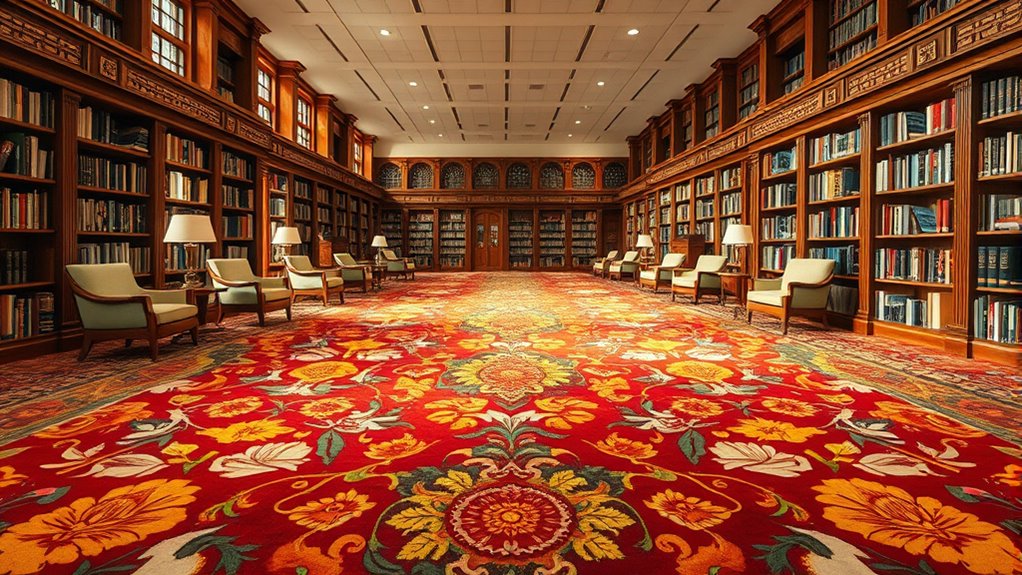
Maintaining the appearance and effectiveness of your library carpets requires regular care and attention. Implement consistent cleaning procedures, such as vacuuming daily to remove dust and debris that can wear down fibers. Promptly address spills to prevent stains from setting, which is essential for stain prevention. Use appropriate cleaning solutions tailored to your carpet type, and avoid harsh chemicals that can damage the fibers. Consider scheduled deep cleanings with professional equipment to maintain freshness and remove embedded dirt. Placing mats at entrances also helps reduce dirt and moisture tracked onto the carpet. By staying diligent with cleaning procedures and being proactive about stain prevention, you’ll preserve your library’s carpets, ensuring they remain attractive and functional for years to come.
Budget-Friendly Ways to Incorporate Carpets
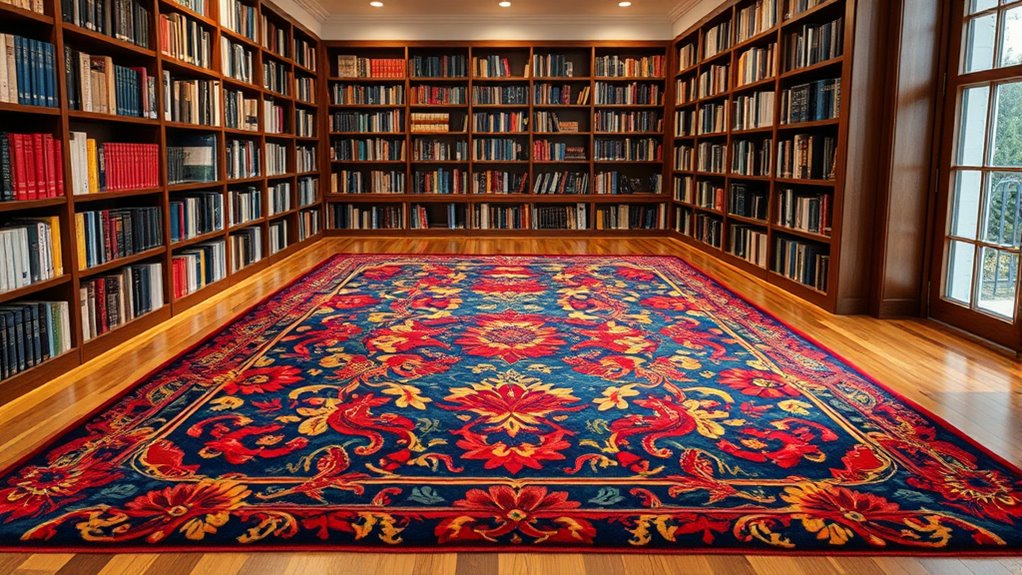
Adding carpets to your library doesn’t have to break the budget. You can find budget-friendly options that still enhance the space’s comfort and style. Look for affordable, durable carpets made from eco-conscious materials, which are better for the environment and your budget. Consider shopping during sales or exploring online marketplaces for discounts. Renting or repurposing carpets from other spaces can also save money while maintaining an eco-conscious approach.
- Shop sales and clearance events for cost-effective options
- Choose eco-friendly, sustainable materials to align with environmental values
- Consider renting or repurposing carpets to reduce costs and waste
Inspiring Examples of Library Carpet Decor

Creative library carpet designs can transform a space from ordinary to inspiring. Artistic patterns and historical motifs serve as mesmerizing focal points that elevate the atmosphere. For example, some libraries feature carpets with intricate, colorful geometric patterns that energize the room. Others incorporate historical motifs, like vintage maps or classical symbols, adding a sense of tradition and depth. These designs not only beautify the space but also spark curiosity and conversation among visitors. By choosing bold artistic patterns or meaningful historical motifs, you create a memorable environment that encourages exploration. Large-scale carpets with such inspiring elements can turn a functional area into a striking visual experience, making your library a place where creativity and history seamlessly blend.
Frequently Asked Questions
How Do Large-Scale Carpets Affect the Library’s Overall Ambiance?
Large-scale carpets substantially influence a library’s overall ambiance by enhancing library aesthetics and creating a welcoming atmosphere. You’ll notice that they add warmth and texture, making visitors feel more comfortable and relaxed. These carpets also help define spaces and reduce noise, improving visitor comfort. Overall, they contribute to a cozy, inviting environment that encourages people to stay longer and engage more deeply with the library’s resources.
What Safety Considerations Are Important When Installing Library Carpets?
When installing library carpets, you need to prioritize safety by ensuring fire safety standards are met, such as using flame-retardant materials. Additionally, check slip resistance to prevent accidents, especially in high-traffic areas. Make sure the installation is secure and edges are well-fitted to avoid tripping hazards. Regular maintenance and inspections also help maintain safety, keeping visitors and staff protected while creating a welcoming environment.
Can Carpets Help Reduce Noise Pollution in a Library Environment?
Carpets can definitely help reduce noise pollution in a library environment. They provide excellent sound absorption and acoustic cushioning, which minimizes echo and muffles footsteps. By installing large-scale carpets, you create a quieter space where visitors can focus without distractions. This not only improves the overall ambiance but also enhances speech clarity, making it easier for people to communicate and study comfortably.
Are There Eco-Friendly Carpet Options Suitable for Libraries?
You’re wondering if eco-friendly carpets suit libraries. Absolutely, they do! Look for options made from biodegradable fibers and recycled materials. These carpets help reduce your environmental impact and are safe for indoor air quality. They also offer durability and sound absorption, making your library quieter. By choosing eco-friendly options, you support sustainability while creating a welcoming, environmentally conscious space for readers and staff alike.
How Often Should Library Carpets Be Professionally Cleaned or Replaced?
Like the pages of a well-loved book, your library’s carpets tell a story. For cleaning schedules, you should aim for professional cleaning every 12 to 18 months to maintain freshness. Replacement frequency depends on wear and tear, typically every 5 to 10 years. Regular inspections help you catch signs of damage early, ensuring your carpets remain inviting and durable, just like the knowledge your library preserves.
Conclusion
By choosing the right large-scale carpet, you create a cozy haven amid the vast shelves. It’s easy to overlook durability when prioritizing style, but the perfect rug balances both. While carpets add warmth and echo your theme, neglecting maintenance can turn beauty into burden. Remember, a well-placed carpet isn’t just decoration—it’s the foundation of comfort and functionality. In your library, style and practicality should always walk hand in hand, shaping a space that welcomes and endures.


